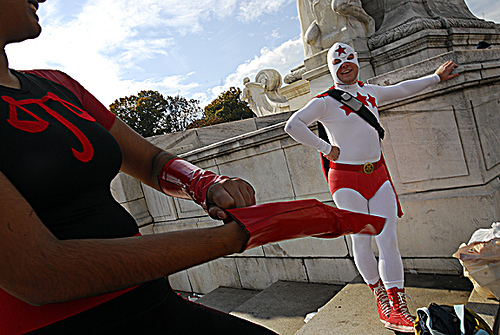Originally posted: http://www.boston.com/ae/movies/articles/2011/04/03/not_so_super_superhero_movies/
By Ethan Gilsdorf
What makes a superhero super?
Comic books came first, then Hollywood, bearing stories about humans, mutants, and others — Hulks, X-Men, Fantastic Four — who got irradiated or experimented upon, or landed on Earth from far-flung planets. As a result, the freaks can leap tall buildings, deflect bullets, shape-shift, and get mad.
But what about unconventional superheroes, the more powerless ones? Hollywood has also covered them. In the category of “superheroes with no real superpowers,’’ there’s the jet-pack powered “The Rocketeer’’ (1991), Shaquille O’Neal in the laughable “Steel’’ (1997), the recent “The Green Hornet’’ and “Iron Man’’ films, and any of the “Batman’’ incarnations. These less-than-super heroes use strength, dexterity, constitution, intelligence, wisdom, charisma, and, naturally, super access to cash and gadgets to bring justice. In the case of “The Phantom,’’ he’s a ghost, which is close enough. In the animated “The Incredibles’’ (2004), we see retired superheroes forced to hide their powers.
Stretch the definition further to include any do-gooder who takes to the streets to deliver justice, and you’ll find action figures straddling that hero/antihero divide: Charles Bronson vigilante types, be they cops or just grim dudes in trench coats. Some are darker than others: “The Punisher’’ (1989, 2004) ticks off a roster of human rights violations — murder, extortion, torture — to punish his foes.
Forget about supervillains.
But what about the rest of us? Everyday Joes and Jills frustrated with crime and tired of lame Neighborhood Watch programs? Folks keen to try out the superhero lifestyle, without any true super powers at all? In the real world, a few nationwide organizations like Superheroes Anonymous (
www.superheroesanonymous.com) and Real Life Superheroes (
www.reallifesuperheroes.org) embolden this fantasy. In cities across America, brave souls take on personas like Terrifica, a New York City-based hero who prevents inebriated women in New York City from being hit on by men, and Mexico City’s Superbarrio, who uses his costumed character to organize labor rallies and lead petition drives. Locally, there’s New Bedford’s Civitron, “a symbol of creative altruism,’’ and Runebringer, an “empowerment activist’’ from Waterbury, Conn.
As in James Gunn’s “Super,’’ these protagonists “aim to do good in the world and inspire others,’’ according to the Superheroes Anonymous website. They wield mundane weapons. They take small bites out of crime. And we salute them.
But before you join them, before you wear the mask and don the cape — and certainly before you engage in some diabolical experiment to alter your DNA — you might want to check how Hollywood advertises the job description. What follows is a roundup of mere mortal beings who nonetheless act big.
In the meantime, dream of the hero you really want to be. Dog Whisperer? Wonder Nurse? Really Good Bookkeeper? Me, I’d settle for Super Unstressed Guy
HERO AT LARGE (1980): This film might have kicked off the ordinary-guy-as-superhero genre. John Ritter plays a struggling actor hired to dress as Captain Avenger at comic book stores and conventions. When he stops a real robbery, life gets complicated. He becomes embroiled in city politics, then redeems himself when he rescues a kid from a fire.
THE GREATEST AMERICAN HERO (1981-83): This ABC television series featured William Katt as a special-education teacher given a red suit and cape by aliens, which give him superhuman abilities. Remember the theme song? “Believe it or not,/ I’m walking on air./ I never thought I could feel so free-ee-eee. . .’’ Believe it or not, that ditty became a Billboard hit.
CONDORMAN (1981): Maybe it was Ronald Reagan’s can-do, American spirit, but the early ’80s brought another DIY superhero story. A comic book artist (Michael Crawford) becomes his creation, Condorman, in what the movie’s tagline calls “an action adventure romantic comedy spy story.’’ Siskel and Ebert pronounced “Condorman’’ one of the worst movies of the year.
DARKMAN (1990): Reportedly stymied in his efforts to film “The Shadow’’ or “Batman,’’ Sam “Evil Dead’’ Raimi came up with his own superhero. The premise: after a disfiguring fire and experimental medical treatment, scientist Liam Neeson develops synthetic skin that lets him look like anyone. He also senses no pain, has super-strength, and flies into rages. Hence, he takes revenge on the mobsters who blew up his lab and turned him into the monster he became, the masked vigilante Darkman.
MYSTERY MEN (1999): In this hilarious spoof on the genre, lesser superheroes with unimpressive super powers must save the day. Blue Raja (Hank Azaria) throws forks, the Shoveler (William H. Macy) shovels, Bowler (Janeane Garofalo) wields bowling balls, Mr. Furious (Ben Stiller) has anger management issues, and Spleen (Paul Reubens) is superflatulent. Super-silly all around.
UNBREAKABLE (2000): Security guard Bruce Willis reluctantly realizes he’s got super powers. In a twist on the genre, Samuel L. Jackson plays his archnemesis — a superweak polar opposite nicknamed “Mr. Glass,’’ because of his brittle bones. Jackson’s character also happens to run a comic book art gallery. Clunky, but effective. From M. Night “Mr. Surprise Ending’’ Shyamalan.
DEFENDOR (2009): In a stretch for Woody Harrelson, he plays a mentally ill construction worker who at night gets into his alter ego, Defendor, thanks to a homemade costume decorated with duct tape. With unconventional weapons like marbles and paper clips, he hunts for his enemy, Captain Industry, whom he blames for the death of his mother. Like “Super,’’ a comedy. Except when it’s not.
KICK-ASS (2010): In this film adaptation of a comic, a wimpy comic book-reading teenager (Aaron Johnson) decides to remake himself as a masked superhero named Kick-Ass. Cops, drug lords, and an 11-year-old vigilante named Hit-Girl (Chloe Moretz) all enter the plot. Apparently a lot of filmmakers and screenwriters read comic books as kids. Like a snake eating its tail, “Kick-Ass’’ represents the self-reflexive endgame of the do-it-yourself crime fighter.


 Originally posted: http://plancast.com/p/7nxk/superheroes-anonymous-year-five-new-york-city
Originally posted: http://plancast.com/p/7nxk/superheroes-anonymous-year-five-new-york-city





